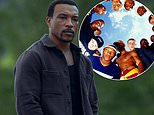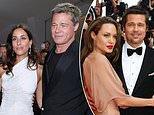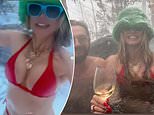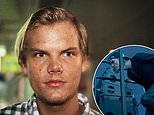Bullseye! How the Queen Mum turned darts players into TV stars: CHRISTOPHER STEVENS reviews last night's TV

Queen Elizabeth, the Queen Mother, and King George VI: In December 1937 they dropped into a social club in Slough and were invited to try out the dartboard
Best of order, please, ladies and gentlemen. An unseemly ruckus broke out among armchair athletes after racing driver Lewis Hamilton won the BBC’s Sports Personality Of The Year, beating golfer Rory McIlroy narrowly into second place.
To impartial observers, this seemed the only fair and equitable outcome. The definition of a sport, after all, is any game that cannot be played while smoking a cigarette.
So chess is a game, and rugby is a sport; F1 motor-racing is undeniably a sport, and golf is just a game for middle-aged men who enjoy a walk but don’t want to go to all the trouble of owning a dog.
The king of games, the one pastime that should only ever be played in a fug of tobacco fumes, is darts. Like dominoes and shove ha’penny, it thrives in working men’s clubs and the kind of pubs that disdain to serve any meals more nutritious than salt ’n’ vinegar crisps.
Unlike dominoes and shove ha’penny, darts became a TV sensation and gave us national heroes such as Eric Bristow and Jocky Wilson — just as another working-class game on television did, when snooker turned Alex Higgins and Ray Reardon into superstars.
So it was a delight to discover on Bullseyes And Beer (BBC4), a typically entertaining Timeshift documentary, that the first darts craze was started by the Queen Mum. She appreciated a well-stocked bar, after all, and she knew the curative properties of a smoke: with a G-and-T in her hand and a Woodbine on the go, Her Majesty was born to play darts.
In December 1937, King George VI and Queen Elizabeth, mother of the present monarch, dropped into a social club in Slough, near Windsor Castle, and were invited to try out the new dartboard. The King scored 19 with three darts; the Queen stepped confidently up to the oche or toe-line, and threw 21.
That was it — everyone in Britain wanted to learn the game. Dart palaces sprang up, like bowling alleys, with rows of boards and lads scurrying to collect the arrows for the middle-class darters.
A jaunty ditty swept the music halls: ‘Let’s have a jolly old game of darts!’ The craze was forgotten with the war, a couple of years later, but we shouldn’t have been surprised when the game swept Britain again in the Seventies.
This blissfully nostalgic documentary reminded us of how a rowdy audience enjoyed itself in the era before the Jeremy Kyle Show. A packed hall of enthusiasts with beer cans and ashtrays settled in to cheer their heroes and boo the villains: author Martin Amis called it ‘tiddlywinks in a bearpit,’ but this was more like a wrestling bout with added maths.
Darts is a mental workout. It requires lightning bursts of arithmetic, to calculate the quickest path to a winning score. And this cerebral element was brilliantly highlighted by Sid Waddell, perhaps the most poetic commentator ever to raise a microphone to his lips.
We heard clips of his style, such as his description of ‘the unique Bristow stance, like a praying mantis’. But there wasn’t enough Waddell, and there were rather too many throw-by-throw reconstructions of classic championships. By the time the hour ended, we had only reached 1990 — it was like getting chucked out at closing time, with the game half finished.

Feeble end: It was if presenter Richard Hammond had lost interest and wanted to play with something else
Richard Hammond reached the end of his three-part study of hurricanes, hailstorms and heatwaves, Wild Weather (BBC1), with a sudden guilty lurch — he’d forgotten to tell us about thunder and lightning.
His busy globetrotting had turned into a whirlwind of travel: stirring up a dustcloud in the Australian desert, spraying trees with liquid ice in Canada, shining lasers through artificial fog in the U.S.
It all seemed to be building to a magnificent finale, so the hurried segment in an Oxfordshire lab, creating a 6in streak of lightning, was a miserable disappointment.
Lightning bolts can split trees in half. Hammond was impressing nobody when he used his artificial thunderstorm generator to blow some candles out.
It was a feeble end to a decent series, as if the presenter had lost interest and wanted to play with something else.
Most watched News videos
- Scottish woman has temper tantrum at Nashville airport
- Tesla Cybertruck explodes in front of Trump hotel in Las Vegas
- Mass panic as New Orleans attacker flies down Bourbon street
- Shocking moment zookeeper is fatally mauled by lions in private zoo
- Horrific video shows aftermath of New Orleans truck 'attack'
- Meghan Markle celebrates new year in first Instagram video
- Tesla Cybertruck burns outside Trump hotel in Las Vegas
- See how truck that drove into crowd made it through police barrier
- Cheerful Melania Trump bops to YMCA at Mar-a-Lago NYE bash
- New Orleans terror attack suspect reveals background in video
- Plane passenger throws drink at flight attendant in boozy fight
- Horrifying moment yacht crashes into rocks and sinks off Mexico coast



































































































































































































































































































































































